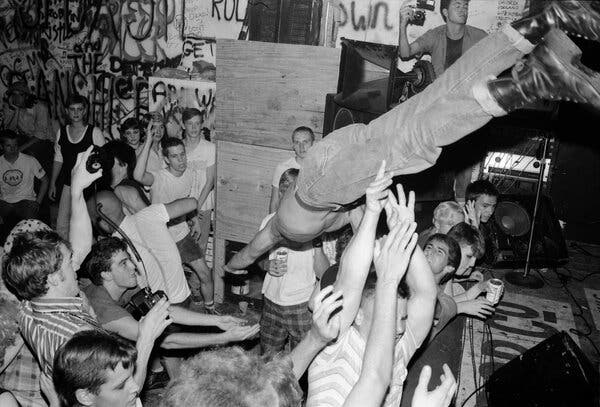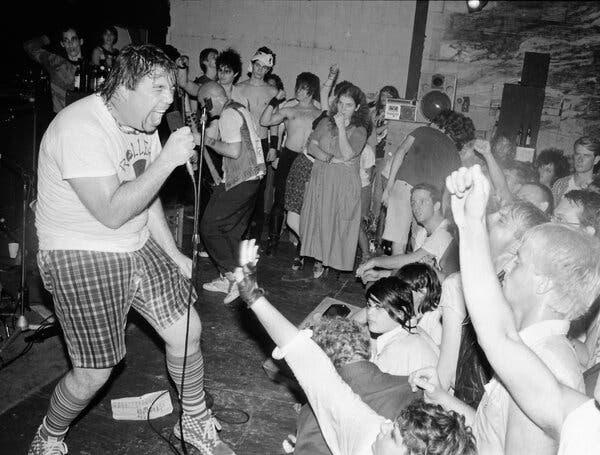Advertisement
Pat Blashill’s photo book “Texas Is the Reason” captures the energy and anarchy of Austin’s burgeoning scene between 1979 and 1987.

By Jeremy Gordon
Photographs by Pat Blashill
Over the last seven months, American life has cautiously adjusted to the strictures of quarantine. We eat in the street, pull up to drive-in theaters and watch live music via our laptops.
Best intentions aside, the tactile experience of a concert — the sweat, the volume, the beer that guy just spilled on you — can’t be replaced by anything but the real thing, which may remain impossible until well into 2021. So it’s with some wistful irony that the writer and photographer Pat Blashill released “Texas Is the Reason,” a photo book telling the story of the 1980s Austin, Texas, punk rock scene, in February, less than a month before the country locked down.
In over 200 pages of black-and-white photography, Blashill vividly captures the wild fury of native bands like the Butthole Surfers, Poison 13, Scratch Acid, the Dicks and many more who made their state an unexpected stronghold of the American independent underground. Beyond the music, he lavishes just as much attention on the patrons and locations who made up the scene, presenting them as though they were stars, too.
“That’s what I miss — the life onstage and offstage, the moment when people show themselves, and maybe it means a lot because you’ve had a beer or smoked a joint,” he said in a Zoom interview.
An Austin native, Blashill fell into the scene after his friend Steve Collier invited him to see his band, Kaye Mart and the Shoppers, who eventually became Big Boys. Punk rock was just a few years old, and the genre’s anarchic spirit inspired listeners to mimic the energy they saw onstage. “There was no barrier between you and the band, and that was really impressive,” Blashill said. “Texas Is the Reason” was culled from roughly 20,000 photos he shot between 1979 and 1987, before he moved to New York City to become a more traditional music writer.
Part of the scene’s vibrancy stemmed from its roots in Texas, which by the 1980s had only further consolidated its national reputation as a conservative stronghold. Hemmed in by heavily entrenched social pressures, young Texan weirdos couldn’t help but rebel. The bands and their fans were bullish, but fiercely supportive of each other. “As long as it was kind of extreme, you could do whatever you wanted to,” Blashill said. “But people also carried with them some sort of ideas about how to behave. Even if they looked really scary — doing insane performances involving dildos or pieces of meat and stuff — they were still kind of sweet.”
Blashill moved to Vienna with his family in 2005, where he currently teaches high school. Last fall, before the book came out, he flew to Austin to showcase the photos for many of the people who appear in them. “It was an overwhelming event,” he said, of catching up with so many friends at once. Eventually, our stages and pits will be filled again too.

Though the singer Glenn Danzig (pictured in the background) would become generationally revered for his pioneering style of gothic punk, his band Samhain played an unexpected role during this 1984 night at Liberty Lunch: second billing. That evening Big Boys, who were the scene’s unofficial benefactors, headlined a show that demonstrated their status: Just before this photo was taken, the lead singer Randy Turner, known as Biscuit, spotted a Nazi recruiter passing out literature in the crowd and instructed the audience to jump him.
“In a minute it was just a melee,” Blashill said. Though the offender was escorted out without further violence, the incident had rippling ramifications. Tim Kerr, the guitar player, “was horrified the band had such power that they could tell people in the audience to do something and people would do it,” Blashill said. “I can’t speak for Biscuit — he’s passed on — but there may not have been agreement on his part that that was a terrible thing.” With existing tensions newly exacerbated, the band broke up later that night.
The ideological gap between the scene’s characters and their conservative state was apparent during the 1984 Republican National Convention, which took place in Dallas and attracted nightly protests and shows where regional bands were all too happy to air out their grievances. By day, Blashill worked at the convention as a runner for The Associated Press, where he caught these young women intently displaying American flags.
Blashill said that King Coffey from the Butthole Surfers tells stories “about walking into Burger King in some small town where a cowboy would walk in, look at him, say ‘I don’t like it,’ and just cold-cock him. There was that resistance to the resistance.”
Nearly all of the venues from this era are gone, but one that Blashill didn’t particularly mourn is Voltaire’s, which he called “the worst kind of a fire trap” — a basement underneath a warehouse with one set of metal stairs leading downstairs.
The venue’s final night was highlighted by Scratch Acid, a howling noise act fronted by the singer David Yow. “David is one of the funniest human beings in the world, but also a real goofball, and I didn’t take him seriously as a performer even when the band was really already good,” Blashill said. The band’s first EP, “Scratch Acid” from 1984, changed things. “I was like, how could somebody I know make this important music?” Yow went on to play in the Jesus Lizard, and Blashill is fairly certain the guitarist Brett Bradford, who’s seen on the left, ended up naked by the end of this night.
In a scene filled with discordant, noisy freaks, the Butthole Surfers managed to stick out with their experimental sound and the way they exemplified their home state’s rebellious ethos by subverting outside stereotypes. “They played up their Texanness by literally playing slack-jawed yokels,” Blashill said. “Most Austin bands didn’t quite take it that far, but the Buttholes really were conscious of the way that a lot of people see Texas.” This photo was taken during a small music festival staged on one of the lakes bordering the city where “this crazy, skronking horrible noise” stood in contrast with the beautiful scenery.
Thanks to its late hours, the regional sandwich chain Thundercloud Subs was a place where punks congregated after concerts. On this night, Blashill tagged along with Ralph Armstrong (left), who was “one of the people in the crowd that was just at every show. She was a bit rough, but she wasn’t mean.” Sandwich in hand or not, she wasn’t going to pass up the chance at young love. “I’d never seen Ralph kiss a girl before, but it just seemed to make perfect sense at two o’clock in the morning,” Blashill said.
When the Bay Area hardcore bang Fang showed up to Liberty Lunch, Blashill wasn’t expecting anything in particular. “I showed up because it was another show, but everybody was just crazy, off the hook,” he said. Even by raucous local standards, the energy between the band and the audience was ferocious, with the crowd spilling onto the stage.
Fang would go on hiatus in 1989 when the singer Sam McBride was charged with voluntary manslaughter and sentenced to prison for killing his girlfriend. McBride served six years of his 11-year sentence before he was released and has recently operated a sober living house in addition to performing and recording with a reconstituted Fang. “He took a picture of himself holding the book and saying that he really liked it,” Blashill said.
The Drag is a stretch of Austin that runs along the University of Texas campus and was originally home to dozens of local businesses. Blashill was walking it with some friends one day when Mikey Milligan, a skateboarder he casually knew, told him to take a look at the trick he was about to perform. When Blashill resurfaced the photo while putting together his book, he realized Milligan was flipping off a car belonging to a member of U.T. Austin’s Greek community.
“Frats and punks were perennial enemies,” he said. (The tension is rendered somewhat lovingly in the 2016 Richard Linklater film “Everybody Wants Some!!”) “The frat boys were constantly hunting punk rockers, sometimes hurting us. The punks would sometimes get some revenge by setting a dumpster on fire, and shoving it into a frat party or something.”
Despite his occasionally menacing stage presence, the Big Boys frontman Randy Turner was what Blashill calls a “godfather, or den mother” to the local punks. He’s seen here in his 1953 Chevrolet Bel Air, a spacious car that had the odd effect of making the singer — by all accounts a proper standard-bearer of his band’s name — look small. “He was super, super approachable and he was always making friends,” Blashill said. “He was really good at introducing people, so I think that car was probably more like a bus for some.”
Blashill met the punk fans Lynda Stuart (right) and Rene Stuart at a show when he spotted them moshing in the front. “I saw them slam dancing arm-in-arm,” he said. “They just struck me as sisters, if not by blood.” He ended up going over to Lynda’s parents’ house, where she was living, to take pictures, ignoring the boyfriends who were hanging around just out of frame. The two women are still in touch, though age has brought a change of occupation: Lynda is a schoolteacher, just like Blashill.
If Big Boys were the scene’s heart and soul, the Dicks were its clenched fist. Fronted by the openly gay singer Gary Floyd, they brought an ardently political edge with anti-police anthems like “Dicks Hate Police” and “Pigs Run Wild,” and cultivated an inclusive crowd that transcended the macho energy punk often attracted.
“What I like about those pictures is you can see lots of women up front,” Blashill said. “That’s always a good sign if women aren’t scared some big beefy guy’s going to knock them over, and some of them are really kind of communing with Gary.” Blashill said he was scared of Floyd, and didn’t talk to him until years later when he was putting the book together. “David Yow will say that was the first band he saw that it was good if the band scared the audience. He thought they were terrifying, which is saying something coming from David Yow.”
Austin was an attractive destination for touring bands looking for a friendly crowd, especially in a state as big and occasionally unwelcoming as Texas. “It was sort of an oasis in the middle of the country,” Blashill said. “When bands hadn’t been there before, they would be surprised that it was so many people at the show, and that people knew the band’s music, and that it was such a fertile scene.”
The Replacements, hailing from Minnesota, brought an outsized reputation as an alternately transcendent and chaotic band. Blashill only experienced the good side: “I never saw the sloppy, drunk, messed-up Replacements,” he said. “There was no problem finishing songs; they were just really on.” They came to Liberty Lunch in the dead of winter, and because the venue was half outdoors, plenty of the punks kept their jackets on. “People were setting fires in metal trash cans to stay warm. It seemed really cold, but being Texas it was probably just in the upper 40s.”